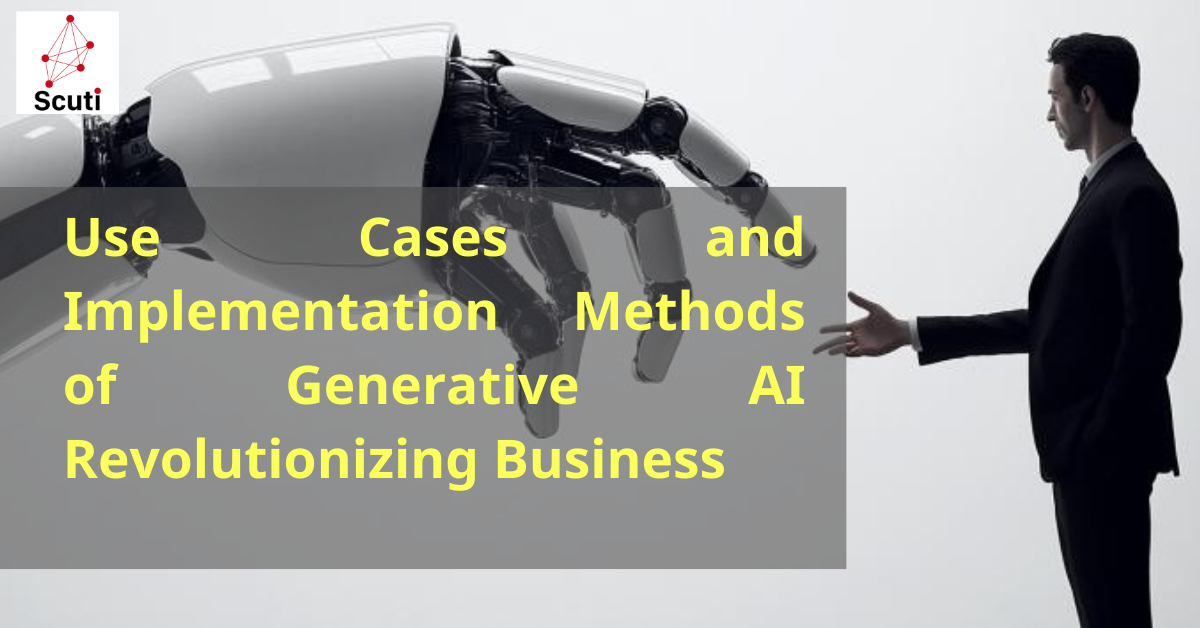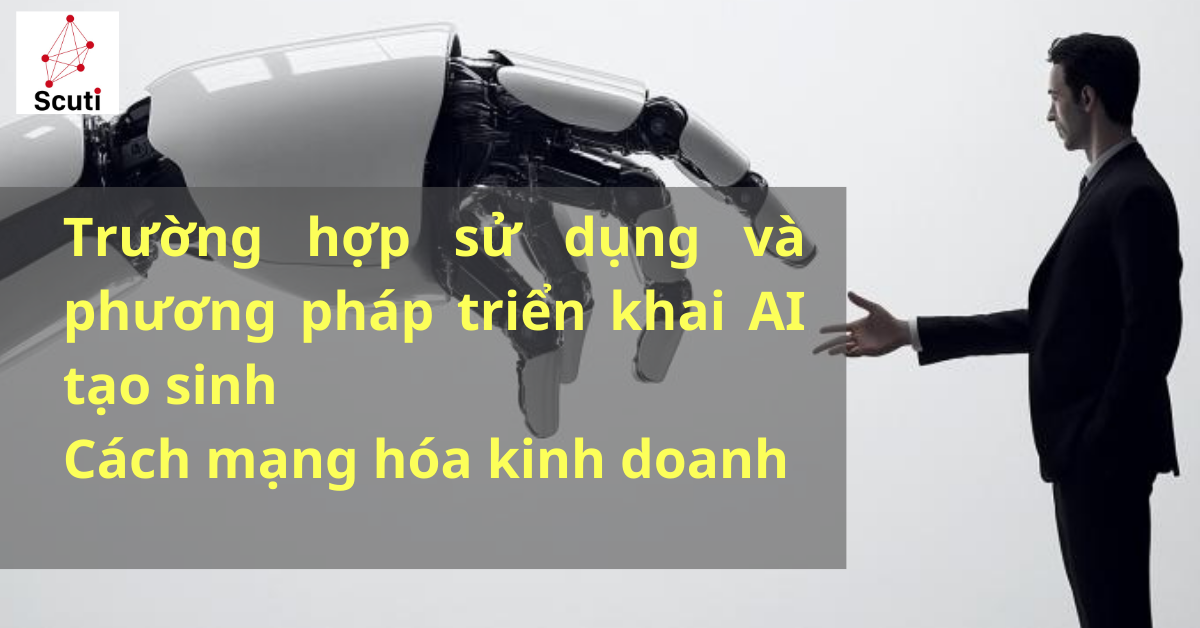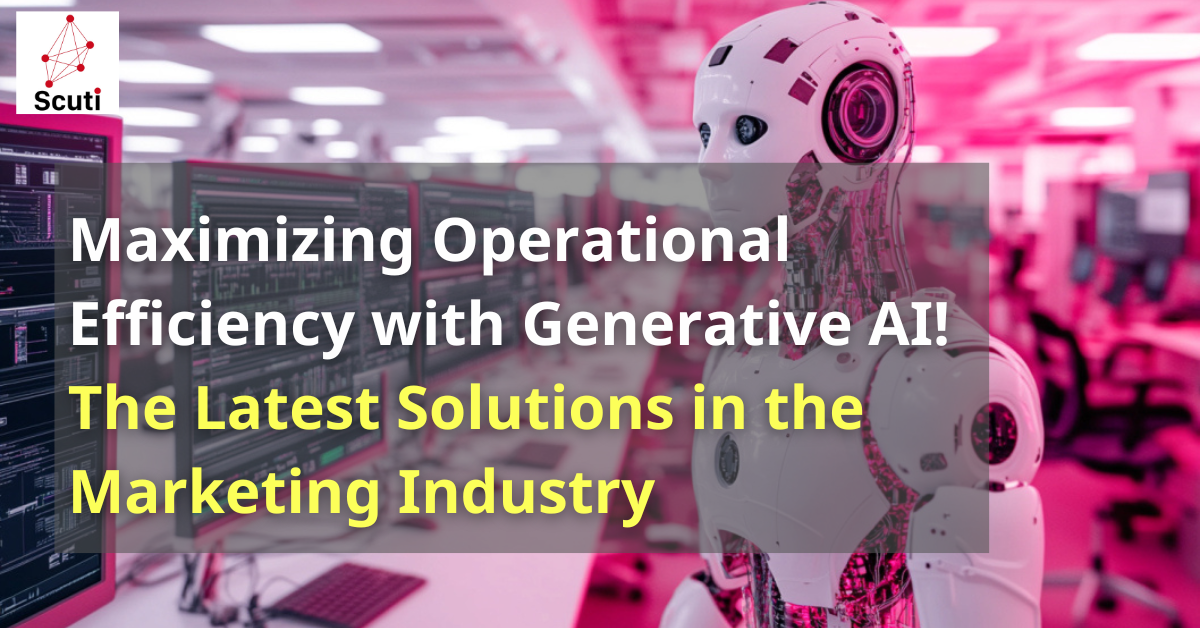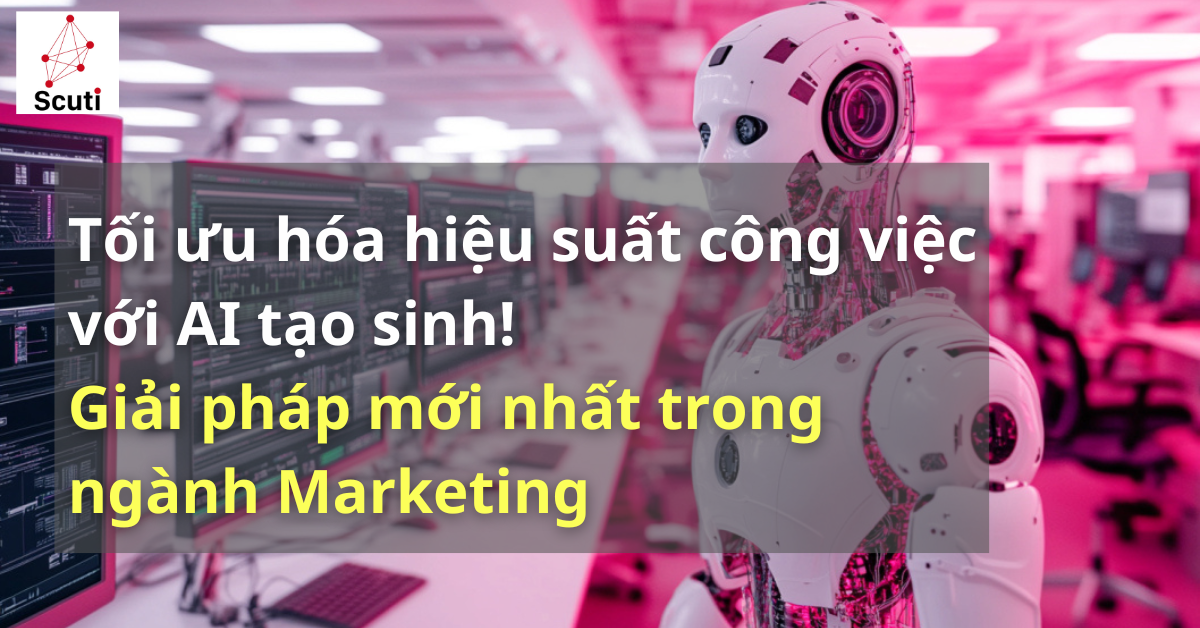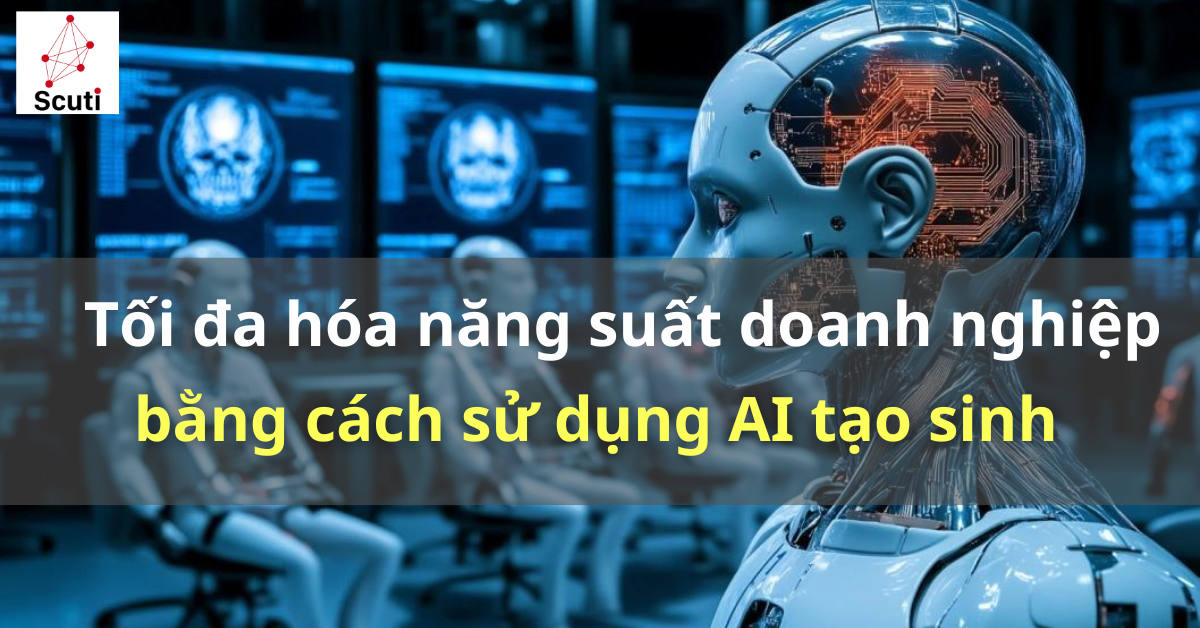
Xin chào, tôi là Kakeya, đại diện của Scuti.
Công ty chúng tôi cung cấp các dịch vụ như phát triển offshore tại Việt Nam và phát triển kiểu lab với điểm mạnh là AI tạo sinh. Gần đây, chúng tôi rất vui mừng khi nhận được nhiều yêu cầu phát triển hệ thống tích hợp AI tạo sinh.
Việc triển khai AI tạo sinh mang đến một cơ hội lớn cho các công ty nhằm nâng cao năng suất và tinh gọn quy trình.
Tuy nhiên, nếu không hiểu đúng cách thức triển khai và sử dụng AI tạo sinh, sẽ không thể tận dụng tối đa giá trị tiềm năng của nó. AI tạo sinh đề cập đến công nghệ tạo ra nội dung và dữ liệu mới bằng cách sử dụng kỹ thuật tạo sinh AI, có khả năng xuất ra nhiều định dạng khác nhau như văn bản, hình ảnh, âm thanh và cả video.
Nhiều công ty đang sử dụng công nghệ này để tự động hóa quy trình kinh doanh và đạt được những đổi mới trong lĩnh vực sáng tạo, nhưng phương pháp triển khai đúng đắn và ứng phó với rủi ro là điều cần thiết.
AI tạo sinh là gì?

Định nghĩa và cơ chế của AI tạo sinh
AI tạo sinh là một công nghệ AI tạo ra nội dung và dữ liệu mới như một người sáng tạo. Nó học hỏi các mẫu và quy tắc từ một lượng lớn dữ liệu và dựa trên kiến thức đó, có thể tạo ra văn bản tự nhiên, hình ảnh, âm nhạc và nhiều hơn nữa, giống như con người đã tạo ra.
Ví dụ, một AI tạo sinh được đào tạo từ một số lượng lớn các bức tranh có thể tạo ra những tác phẩm nghệ thuật mới, và một AI được đào tạo từ nhiều tác phẩm âm nhạc có thể sáng tác những bản nhạc gốc. Ngoài ra, một AI tạo sinh được đào tạo từ nhiều dữ liệu văn bản có thể tạo ra văn bản tự nhiên giống như con người đã viết, tạo ra tiểu thuyết, bài báo, thơ ca và nhiều hơn nữa.
Theo cách này, AI tạo sinh có khả năng mở rộng sự sáng tạo của con người và tạo ra những nội dung mới chưa từng tồn tại trước đây.
AI tạo sinh có thể làm gì
AI tạo sinh là một công cụ mạnh mẽ giúp hình thành trí tưởng tượng của chúng ta. Nó có thể tự động tạo ra nhiều loại đầu ra khác nhau, bao gồm văn bản, hình ảnh, âm thanh và mã chương trình.
Ví dụ, nó ngày càng được sử dụng nhiều trong các bối cảnh kinh doanh, chẳng hạn như chatbot tự động phản hồi các câu hỏi của khách hàng và các công cụ tiếp thị tạo ra các đoạn quảng cáo hấp dẫn và câu slogan. Hơn nữa, nó mở ra những khả năng mới trong nghệ thuật, cho phép tạo ra các thiết kế sản phẩm sáng tạo và các bản nhạc hoặc tranh vẽ.
AI tạo sinh kích thích sự sáng tạo của chúng ta và có khả năng thúc đẩy sự đổi mới trong nhiều lĩnh vực khác nhau.
Thuật toán của AI tạo sinh

Thuật toán đại diện và đặc điểm của chúng
Có nhiều loại thuật toán khác nhau để thực hiện AI tạo sinh. Dưới đây là một số thuật toán điển hình:
Đầu tiên là GAN (Mạng đối kháng tạo sinh). GAN là một thuật toán sử dụng hai mạng nơ-ron (mạng tạo sinh và mạng phân biệt) để đào tạo. Mạng tạo sinh học cách sản xuất dữ liệu giống như dữ liệu thực, trong khi mạng phân biệt học cách phân biệt giữa dữ liệu thực và dữ liệu được tạo ra. Bằng cách cho hai mạng này cạnh tranh với nhau, việc tạo ra dữ liệu có độ chính xác cao hơn trở nên khả thi. GAN đã đạt được hiệu suất cao, đặc biệt trong lĩnh vực tạo hình ảnh.
Thứ hai là VAE (Mã hóa biến thiên). VAE là một thuật toán trích xuất các đặc điểm của dữ liệu và sử dụng những đặc điểm đó để tạo ra dữ liệu mới. Bởi vì VAE có thể học các đặc điểm tiềm ẩn của dữ liệu, nó có thể tạo ra một bộ dữ liệu đa dạng hơn so với GAN.
Các điểm cần lưu ý khi chọn thuật toán
Khi chọn thuật toán phù hợp nhất cho một dự án AI tạo sinh, cần phải xem xét các mục tiêu của dự án, đặc điểm dữ liệu và độ chính xác cần thiết. Ví dụ, nếu cần tạo hình ảnh với độ chính xác cao, GAN là lựa chọn phù hợp, trong khi VAE có thể phù hợp hơn nếu muốn tạo ra dữ liệu đa dạng.
Các bước triển khai AI tạo sinh

Làm rõ mục tiêu kinh doanh
Để triển khai AI tạo sinh thành công, điều quan trọng là phải làm rõ các mục tiêu kinh doanh.
Bằng cách xác định cụ thể “bạn muốn đạt được điều gì” và “các hoạt động nào bạn muốn tinh gọn” thông qua AI tạo sinh, bạn có thể chọn các trường hợp sử dụng phù hợp và tạo ra một kế hoạch triển khai hiệu quả. Ngoài ra, việc giới thiệu AI không chỉ đơn thuần là một lựa chọn kỹ thuật; nó cần phải phù hợp với chiến lược của công ty.
Trước khi triển khai, việc thiết lập sự hiểu biết chung giữa các bên liên quan và đặt mục tiêu từ một góc nhìn toàn diện bao gồm phân bổ nguồn lực và quản lý rủi ro có thể kỳ vọng sẽ tạo ra giá trị bền vững sau khi triển khai.
Lựa chọn và đánh giá các trường hợp sử dụng
Dựa trên các mục tiêu kinh doanh, hãy xem xét cách áp dụng AI tạo sinh cho các hoạt động khác nhau.
Nhiều trường hợp sử dụng có thể được xem xét, chẳng hạn như tự động hóa hỗ trợ khách hàng, tạo nội dung tiếp thị và phát triển sản phẩm mới. Mỗi trường hợp sử dụng nên được đánh giá về khả năng thực hiện và chi phí để chọn ra trường hợp tối ưu.
Hơn nữa, cần phải xem xét cách mà các trường hợp sử dụng đã chọn sẽ ảnh hưởng đến quy trình kinh doanh tại chỗ, bao gồm không chỉ việc giảm bớt công sức và tăng tốc độ mà còn các khía cạnh như cải thiện chất lượng và tăng sự hài lòng của khách hàng. Tìm ra các trường hợp sử dụng góp phần vào sự phát triển lâu dài của công ty là bước đầu tiên dẫn đến thành công.
Lập kế hoạch dự án và xây dựng cơ cấu tổ chức
Dựa trên các trường hợp sử dụng đã chọn, hãy phát triển một kế hoạch dự án cụ thể.
Làm rõ các nhiệm vụ cụ thể và lịch trình cho việc thu thập dữ liệu cần thiết, phát triển mô hình AI, tích hợp hệ thống và xây dựng cơ cấu vận hành. Ngoài ra, hãy tổ chức một đội ngũ để thúc đẩy dự án tiến triển, làm rõ vai trò và trách nhiệm. Hơn nữa, hãy lập kế hoạch trước cho các chiến lược để đối phó với những rủi ro và thách thức có thể phát sinh trong quá trình thực hiện dự án, tạo ra một hệ thống phản ứng linh hoạt.
Cũng quan trọng là thiết lập các phương thức giao tiếp với các bên liên quan và một cơ cấu báo cáo để nâng cao tính minh bạch của dự án và theo dõi chính xác tiến độ. Hơn nữa, việc củng cố sự hợp tác giữa các bên liên quan và xem xét hợp tác với các đối tác bên ngoài hoặc chuyên gia khi cần thiết cho sự thành công của dự án cũng rất quan trọng.
Ngoài ra, cần thiết phải ưu tiên phản hồi và định kỳ xem xét kế hoạch để duy trì hướng đi tối ưu nhằm đạt được các mục tiêu của dự án. Điều này sẽ dẫn đến sự thành công của dự án triển khai AI tạo sinh.
Thực hiện PoC (Bằng chứng khái niệm)
Trước khi triển khai quy mô lớn, việc thực hiện một PoC quy mô nhỏ để xác minh tính khả thi và hiệu quả là điều được khuyến nghị. Trong PoC, dữ liệu thực được sử dụng để phát triển mô hình AI, và được đánh giá xem liệu có đạt được kết quả như mong đợi hay không và liệu có thể kỳ vọng vào hiệu quả của việc triển khai hay không. Dựa trên kết quả của PoC, có thể cần phải sửa đổi kế hoạch triển khai hoặc xem xét lại các trường hợp sử dụng.
Triển khai dần dần và xác minh hiệu quả
Nếu kết quả của PoC là tốt, bạn có thể tiến hành triển khai quy mô lớn. Tuy nhiên, không nên triển khai ngay lập tức trên toàn công ty, mà trước tiên nên thử nghiệm trong một bộ phận hoặc cho các hoạt động cụ thể, xác minh hiệu quả trong khi mở rộng dần dần việc sử dụng. Sau khi triển khai, việc đo lường hiệu quả định kỳ và, nếu cần thiết, thực hiện lại việc huấn luyện mô hình AI và cải thiện hệ thống để tối đa hóa hiệu quả của AI tạo sinh là điều rất quan trọng.
Các điểm cần lưu ý trong việc triển khai AI tạo sinh

Các yếu tố đạo đức
Khi sử dụng AI tạo sinh, việc xem xét các khía cạnh đạo đức là điều không thể thiếu. Cần xem xét trước liệu nội dung mà AI tạo sinh sản xuất có phù hợp về mặt đạo đức hay không và liệu có vấn đề nào liên quan đến quyền tác giả và quyền riêng tư hay không.
Hơn nữa, việc sử dụng AI tạo sinh có thể khuyến khích sự thiên lệch hoặc phân biệt, vì vậy việc đảm bảo sự công bằng trong việc lựa chọn tập dữ liệu và thiết kế mô hình cũng rất quan trọng. Thêm vào đó, việc làm rõ nguồn gốc của nội dung được tạo ra và quy trình tạo ra nó cho người sử dụng cũng là cần thiết để nâng cao tính minh bạch và tăng cường độ tin cậy. Việc phát triển các hướng dẫn đạo đức và nâng cao nhận thức của nhân viên thông qua giáo dục liên tục cũng là một phần của trách nhiệm doanh nghiệp.
Điều này sẽ giúp xem xét tác động của việc sử dụng AI đối với xã hội và đóng góp cho sự phát triển bền vững. Hơn nữa, việc tiếp nhận phản hồi từ người sử dụng và tiếp tục cải tiến cũng rất quan trọng. Điều này sẽ thúc đẩy việc sử dụng AI đúng cách và xây dựng lòng tin trong xã hội.
Các biện pháp an ninh
Dữ liệu học tập và dữ liệu được tạo ra từ AI tạo sinh là tài sản thông tin quan trọng đối với các doanh nghiệp, do đó cần phải thực hiện các biện pháp an ninh thích hợp.
Để ngăn ngừa rò rỉ dữ liệu và truy cập trái phép, cần triển khai phần mềm bảo mật, thiết lập quyền truy cập và xây dựng chính sách bảo mật. Ngoài ra, việc thực hiện các cuộc kiểm tra an ninh định kỳ và đánh giá lỗ hổng là rất quan trọng để xác định điểm yếu của hệ thống và thực hiện các biện pháp kịp thời. Nhân viên cũng cần được đào tạo để nâng cao nhận thức về an ninh và nâng cao kiến thức về quản lý dữ liệu và mật khẩu.
Thêm vào đó, việc xem xét lại quy trình quản lý dữ liệu và thực hiện mã hóa hoặc sao lưu khi cần thiết có thể tăng cường bảo vệ dữ liệu. Điều này sẽ nâng cao độ tin cậy của doanh nghiệp và xây dựng lòng tin từ khách hàng và đối tác.
Học hỏi liên tục và cải tiến
Việc triển khai AI tạo sinh không phải là một sự kiện chỉ diễn ra một lần. Các mô hình AI liên tục học hỏi từ dữ liệu mới để cải thiện độ chính xác của chúng. Thêm vào đó, việc xem xét lại các trường hợp sử dụng và phương pháp triển khai AI tạo sinh để đáp ứng với sự thay đổi của môi trường kinh doanh và nhu cầu khách hàng cũng rất quan trọng.
AI tạo sinh là một công nghệ có khả năng mang lại sự chuyển biến đáng kể cho các doanh nghiệp. Các công ty có thể tối đa hóa lợi ích bằng cách hiểu các bước triển khai AI tạo sinh và các yếu tố chính cần cân nhắc, đồng thời tiến hành kế hoạch và chuẩn bị phù hợp.
Tóm tắt

AI tạo sinh có khả năng đóng góp đáng kể vào việc cải thiện năng suất của doanh nghiệp.
Để đảm bảo việc triển khai thành công, việc đặt ra các mục tiêu rõ ràng, lựa chọn các trường hợp sử dụng phù hợp, xác minh thông qua PoC (Bằng chứng khái niệm), và xây dựng một cơ cấu vận hành bền vững là rất quan trọng. Bằng cách tham khảo các trường hợp thành công, có thể đạt được sự sáng tạo đổi mới.
AI tạo sinh không chỉ là một công cụ; nó có thể là một đối tác mạnh mẽ với khả năng thay đổi lớn trong tương lai của các doanh nghiệp.

